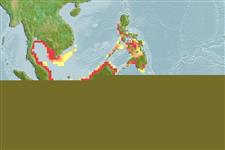Lớp phụ Cá sụn (cá mập và cá đuối) (sharks and rays) >
Rhinopristiformes (Shovelnose rays) >
Rhinidae (Wedgefishes)
Etymology: Rhynchobatus: Greek, rhingchos = snout + Greek, batis, -idos = a sting ray (Raja sp.) (Ref. 45335); springeri: Named for Stewart "Stew" Springer.
Eponymy: Stewart ‘Stew’ Springer (1906–1991) was a field naturalist who dropped out of Butler College (1929) but was awarded a baccalaureate by George Washington University (1964), by which time he was world-renowned as an expert on both the taxonomy and [...] (Ref. 128868), visit book page.
More on authors: Compagno & Last.
Environment: milieu / climate zone / depth range / distribution range
Sinh thái học
Biển; Thuộc về nước lợ; Mức độ sâu 16 - 37 m (Ref. 84284). Tropical; 20°N - 10°S, 95°E - 128°E (Ref. 114953)
Indo-Malay: from Java (Indonesia) to Thailand, including Borneo, Singapore
and the Philippines..
Bộ gần gũi / Khối lượng (Trọng lượng) / Age
Maturity: Lm ? range ? - 125 cm
Max length : 215 cm TL con đực/không giới tính; (Ref. 84284); 213.0 cm TL (female)
Short description
Khóa để định loại | Hình thái học | Sinh trắc học
This moderate-sized species is distinguished by the following set of characters: snout broadly wedge-shaped; preoral snout 16-22% of total length; eye small, length 3.1-4.0 in preorbital snout; interorbital space 2.2-2.7 in preorbital snout; mouth hardly bowed, with strong indentation on upper jaw near symphysis and strong protuberance on lower jaw; tooth rows in upper jaw about 52 (holotype); dorsal snout no spines; dorsal tip of snout with no rostral spines or spines; supraorbital spines small but well differentiated, extending from preorbit to end of spiracle; spines of mid-dorsal row relatively well developed; two obvious rows of small scapular spines on each side; origin of first dorsal fin over origin of pelvic fin bases; predorsal space 42-48% of total length; colour pale greyish green above with 3-4 rows of large, white spots extending along the tail; black pectoral marking distinct, usually closely surrounded with 4 white spots (occasionally 3); anterior pectoral disc with narrow whitish margin; orbital membrane with a pair of dark, widely spaced, recurved lines; interorbital space with no alternating light and dark markings; propterygial radials 1-8 + 20-23, mesopterygial radials 4-6, neopterygial radials 4-7, metapterygial radials 23-29, total radials 57-68 (inc. free radials); vertebrae with 12-14 synarcual centra, 18-28 monospondylous precaudal centra, 78-88 precaudal free centra, 33-40 diplospondylous caudal (free) centra, 113-126 total free centra, 127-139 total centra (including synarcual centra) (Ref. 84284).
Apparently confined mainly to brackish coastal and estuarine habitats in shallow water (Ref. 84284). Diet unknown, but presumably similar to other wedgefishes (Ref. 114953).
Life cycle and mating behavior
Chín muồi sinh dục | Sự tái sinh sản | Đẻ trứng | Các trứng | Sự sinh sản | Ấu trùng
Compagno, L.J.V. and P.R. Last, 2010. A new species of wedgefish, Rhynchobatus springeri (Rhynchobatoidei, Rhynchobatidae), from the Western Pacific. 77-88 pp. In Last, P.R., White, W.T. & Pogonoski, J.J. (eds.): Descriptions of new sharks and rays from Borneo. CSIRO Marine and Atmospheric Research Paper no. 32. (Ref. 84284)
IUCN Red List Status (Ref. 130435: Version 2024-1)
Threat to humans
Harmless
Human uses
Các công cụ
Special reports
Download XML
Các nguồn internet
Estimates based on models
Preferred temperature (Ref.
123201): 28 - 29.1, mean 28.7 °C (based on 160 cells).
Phylogenetic diversity index (Ref.
82804): PD
50 = 0.5049 [Uniqueness, from 0.5 = low to 2.0 = high].
Bayesian length-weight: a=0.00372 (0.00163 - 0.00845), b=3.11 (2.91 - 3.31), in cm total length, based on LWR estimates for this (Sub)family-body shape (Ref.
93245).
Mức dinh dưỡng (Ref.
69278): 3.6 ±0.6 se; based on size and trophs of closest relatives
Fishing Vulnerability (Ref.
59153): Very high vulnerability (90 of 100).
